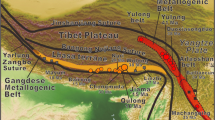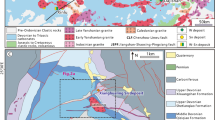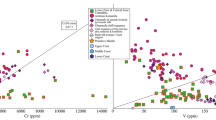Abstract
The paper discusses the results of mineralogical and petrographic studies of spinel lherzolite xenoliths and clinopyroxene megacrysts in basalt from the Jixia region related to the central zone of Cenozoic basaltic magmatism of southeastern China. Spinel lherzolite is predominantly composed of olivine (Fo89.6–90.4), orthopyroxene (Mg# = 90.6–92.7), clinopyroxene (Mg# = 90.3–91.9), and chrome spinel (Cr# = 6.59–14.0). According to the geochemical characteristics, basalt of the Jixia region is similar to OIB with asthenospheric material as a source. The following equilibrium temperatures and pressures were obtained for spinel peridotite: 890–1269°C and 10.4–14.8 kbar. Mg# of olivine and Cr# of chrome spinel are close to the values in rocks of the enriched mantle. It is evident from analysis of the textural peculiarities of spinel lherzolite that basaltic melt interacted with mantle rocks at the xenolith capture stage. Based on an analysis of the P–T conditions of the formation of spinel peridotite and clinopyroxene megacrysts, we show that mantle xenoliths were captured in the course of basaltic magma intrusion at a significantly lower depth than the area of partial melting. However, capture of mantle xenoliths was preceded by low-degree partial melting at an earlier stage.
Similar content being viewed by others
References
P. Bertrand and J. C. C. Mercier, “The mutual solubility of coexisting ortho- and clinopyroxene: toward an absolute geothermometer for the natural system?” Earth Planet. Sci. Lett. 76, 109–122 (1985).
G. P. Brey and T. Koehler, “Geothermobarometry in fourphase Lherzolites II: New thermo- barometers and practical assessment of existing thermobarmetres,” J. Petrol. 31, 1353–1387 (1990).
R. L. Cao and S. H. Zhu, “Correlation of mantle xenolith occurrences with earth’s internal zoning and tectonic in eastern China,” Chinese J. Geophys. 26, 158–167 (1983) (in Chinese with English abstract).
L. Em. and Zhao, D. S. “Cenozoic basalt and xenoliths from depth in eastern China,” (Science Press, Beijing, 1987), pp. 349–475 (in Chinese).
S. Gao, R. L. Rudnick, R. W. Carlson, W. F. McDonough, and Y. S. Liu, “Re–Os evidence for replacement of ancient mantle lithosphere beneath the North China craton,” Earth Planet. Sci. Lett. 198, 307–322 (2002).
W. L. Griffin, A. Zhang, S. Y. O’Reilly, et al. “Phanerozoic evolution of the lithosphere beneath the Sino-Korean craton,” in Mantle Dynamics and Plate Interactions in East Asia, Ed. by M.F.J. Flowe, S.L. Chung, C.H. Lo, and T.Y. Lee, Am. Geophys. Union, Geodynam. Ser. 27, 107–126 (1988).
E. Hellebrand, J. E. Snow, H. J. Dick, and A. W. Hofmann, “Coupled major and trace elements as indicators of the extent of melting in mid-ocean-ridge peridotites,” Nature 410, 677–681 (2001).
C. Herzberg, “Pyroxene geothermometry and geobarometry: experimental and thermodynamic evaluation of some subsolidus phases relations involving pyroxenes in the system CaO–MgO–Al2O3–SiO2,” Geochim Cosmochim Acta 42, 945–958 (1978).
K. S. Ho, J. C. Chen, C. H. Lo, and H. L. Zhao “40Ar–39Ar dating and geochemical characteristics of late Cenozoic basaltic rocks from the Zhejiang–Fujian region, SE China: eruption ages, magma evolution and petrogenesis,” Chem. Geol. 197, 287–318 (2003).
X. X. Huang and Y. G. Xu, “Thermal state and structure of the lithosphere beneath eastern China: a synthesis on basalt-borne xenoliths,” J. Earth Sci. 21, 711–730 (2010).
D. A. Ionov, L. S. Doucet, and I. V. Ashchepkov, “Composition of the lithospheric mantle in the Siberian craton: new constraints from fresh peridotites in the Udachnaya-East kimberlite,” J. Petrol. 51 (11), 2177–2210 (2010).
A. J. Irving and F. A. Frey, “Trace element abundances in megacrysts and their host basalts: constraints on partition coefficients and megacryst genesis,” Geochim. Cosmochim. Acta 48, 1201–1221 (1984).
T. Koehler and G. P. Brey, “Calcium exchange between olivine and clinopyroxene calibrated as a geothermobarometer for natural peridotites from 2 to 60 kb with applications,” Geochim. Cosmochim. Acta 54, 2375–2388 (1990).
M. J. Le Bas, R. W. Le Maitre, A. Streckeisen, and B. Zanettin, “A chemical classification of volcanic rocks based on the total alkali-silica diagram,” J. Petrol. 27, 745–750 (1986).
C. Y. Lin, L. B. Shi, X. D. Chen, and X. L. Han, “Thermal structure and rheology of the upper mantle beneath Mingxi, Fujian Province,” Geol. Rev. 45, 352–360 (1999) (in Chinese with English abstract).
J. M. Liotard, D. Briot, and P. Boivin, “Petrological and geochemical relationships between pyroxene megacrysts and associated alkali-basalts from Massif Central (France),” Contrib. Mineral. Petrol. 98, 81–90 (1988).
J-C. C. Mercier “Single-pyroxene thermobarometry,” Tectonophysics 70, 1–37 (1980).
H. S. C. O’Neill, “The transition between spinel lherzolite and garnet lherzolite, and its use as a geobarometer,” Contrib. Mineral. Petrol. 77, 185–194 (1981).
S. Y. O’Reilly and W. L. Griffin, “4-D lithosphere mapping: methodology and examples,” Tectonophysics 262, 3–18 (1996).
H. N. Pollack and D. S. Chapman, “On the regional variation of heat flow, geotherms, and lithospheric thickness,” Tectonophysics 38, 279–296 (1977).
M. Seyler and E. Bonatti, “Na, AI TM and Al VI in clinopyroxenes of subcontinental and suboceanic ridge peridotites: a clue to different melting processes in the mantle,” Earth Planet. Sci. Lett. 122, 281–289 (1994).
Y. Song, J. Wang, J. L. Liu, Z. P. Xie, and K. H. Hattori, “Mineral chemistry of mantle xenoliths in Cenozoic basalts from Wangqing, eastern Jilin: Implications for formation of newly accreted sub-continental mantle,” Earth Sci. Front. 20, 75–86 (2013) (in Chinese with English abstract).
F. Su, Y. Xiao, H. Y. He, B. X. Su, Y. W, and R. X. Zhu, “He and Ar isotope geochemistry of pyroxene megacrysts and mantle xenoliths in Cenozoic basalt from the Changle–Linqu area in western Shandong,” Chinese Sci Bull. 59, 396–411 (2014).
S. S. Sun and W. F. McDonough, “Chemical and isotopic systematics of oceanic basalts: implications for mantle compositions and processes,” in Magmatism in Ocean Basins, Ed. by A. D. Saunders and M. J. Norry, Geol. Soc. Sp. Publ., 42, 313–345 (1989).
W. Sun, X. Ding, Y. H. Hu, and X. H. Li, “The golden transformation of the Cretaceous plate subduction in the west Pacific,” Earth Planet. Sci. Lett. 262, 533–542 (2007).
R. N. Thompson, “Some high-pressure pyroxenes,” Mineral. Mag. 39, 768–787 (1974).
P. Z. Wang, Y. A. Chen, B. T. Cao, J. D. Pan, and C. Y. Wang, “Crust–upper-mantle structure and deep structural setting of Fujian Province,” Geol. Fujian 12 (2), 79–158 (1993). (in Chinese with English abstract).
U. Wiechert, D. A. Ionov, and K. H. Wedephol, “Spinel peridotite xenoliths from the Atsagin-Dush volcano, Dariganga lava plateau, Mongolia: a record of partial melting and cryptic metasomatism in the upper mantle,” Contrib. Mineral. Petrol. 126, 345–364 (1997).
J. A. Winchester and P. A. Floyd, “Geochemical discrimination of different magma series and their differentiation products using immobile elements,” Chem. Geol. 20, 325–343 (1977).
G. Witt-Eickschen and H. A. Seck, “Solubility of Ca and Al in orthopyroxene from spinel peridotite: an improved version of an empirical geothermometer,” Contrib. Mineral. Petrol. 106, 431–439 (1991).
X. Xu, W. L. Griffin, S. Y. O’Reilly, N. J. Pearson, H. Y. Geng, and J. P. Zheng, “Re–Os isotopes of sulfides in mantle xenoliths from eastern China: progressive modification of lithospheric mantle,” Lithos 102, 43–64 (2008).
X. S. Xu, S. Y. O’Reilly, W. L. Griffin, and X. M. Zhou, “Enrichment of upper mantle peridotite: petrological, trace-element and isotopic evidence in xenoliths from SE China,” Chem. Geol. 198, 163–188 (2003).
X. S. Xu, S. Y. O’Reilly, W. L. Griffin, and X. M. Zhou, “Genesis of young lithospheric mantle in SE China,” J. Petrol. 41, 111–148 (2000).
Y. G. Xu, “Geothermometer applicable to mantle xenoliths,” Acta Petrol. Sin. 9, 167–179 (1993).
Y. Yu, X. S. Xu, W. L. Griffin, S. Y. O’Reilly, and Q. K. Xia, “H2O contents and their modification in the Cenozoic subcontinental lithospheric mantle beneath the Cathaysia block, SE China,” Lithos 126, 182–197 (2011).
Y. S. Yuan, Y. S. Ma, S. B. Hu, D. L. Guo, and X. R. Fu, “Present-day geothermal characteristics in South China,” J. Geophys. 49 (4), 1118–1126 (2006) (in Chinese).
J. Zheng, S. Y. O’Reilly, W. L. Griffin, F. X. Lu, M. Zhang, and N. J. Pearson, “Relict refractory mantle beneath the eastern North China block: significance for lithosphere evolution,” Lithos 57, 43–66 (2001).
J. P. Zheng, “Comparison of mantle-derived matierals from different spatiotemporal settings: Implications for destructive and accretional processes of the North China Craton,” Chinese Sci. Bull. 54, 3397–3416 (2009).
X. M. Zhou and W. X. Li, “Origin of Late Mesozoic igneous rocks in Southeastern China: implications for lithosphere subduction and underplating of mafic magmas,” Tectonophysics 326, 269–287 (2000).
Q. Zhou, F. Y. Wu, Z. Y. Chu, Y. H. Yang, Y. D. Sun, and W. C. Ge, “Isotopic compositions of mantle xenoliths and age of the lithospheric mantle in Yitong, Jilin Province,” Acta Petrol. Sin. 26, 1241–1264 (2010). (in Chinese with English abstract)
H. Zou, A. Zindler, X. S. Xu, and Q. Qi, “Major, trace element, and Nd, Sr and Pb isotope studies of Cenozoic basalts in SE China: mantle sources, regional variations, and tectonic significance,” Chem. Geol. 171, 33–47 (2000).
Author information
Authors and Affiliations
Corresponding author
Additional information
Original Russian Text © G.S. Zhang, A.V. Bobrov, J.S. Long, W.H. Han, 2016, published in Geokhimiya, 2016, No. 10, pp. 931–943.
Rights and permissions
About this article
Cite this article
Zhang, G.S., Bobrov, A.V., Long, J.S. et al. Mineralogical and geochemical patterns of mantle xenoliths from the Jixia region (Fujian Province, southeastern China). Geochem. Int. 54, 901–913 (2016). https://doi.org/10.1134/S0016702916100049
Received:
Accepted:
Published:
Issue Date:
DOI: https://doi.org/10.1134/S0016702916100049




